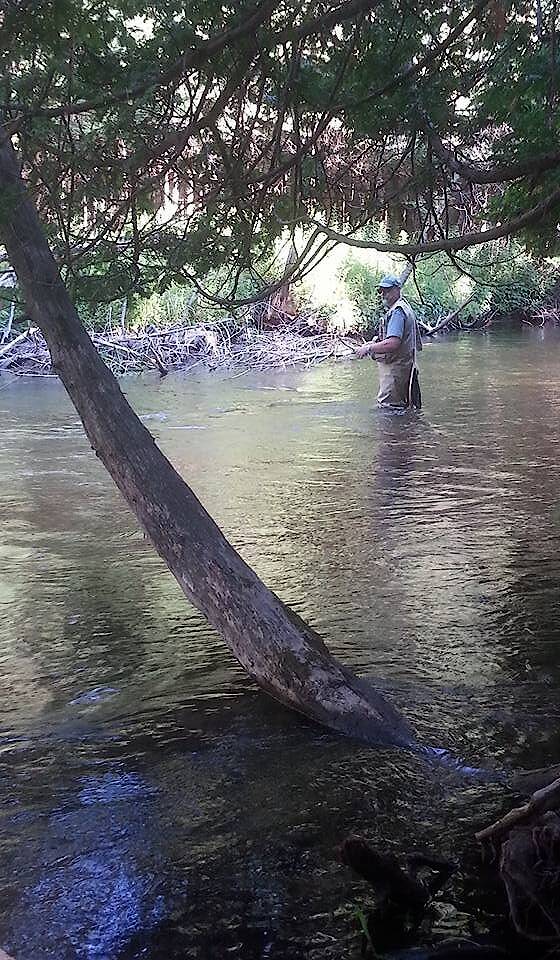
Salmonflies
Pteronarcys californica
The giant Salmonflies of the Western mountains are legendary for their proclivity to elicit consistent dry-fly action and ferocious strikes.
Featured on the forum

This one was surprisingly straightforward to identify. The lack of a sclerite at the base of the lateral hump narrows the field quite a bit, and the other options followed fairly obvious characteristics to Clostoeca, which only has one species, Clostoeca disjuncta.

Troutnut is a project started in 2003 by salmonid ecologist Jason "Troutnut" Neuswanger to help anglers and
fly tyers unabashedly embrace the entomological side of the sport. Learn more about Troutnut or
support the project for an enhanced experience here.
Onthefly11 on Sep 6, 2020September 6th, 2020, 4:16 am EDT
Hi everyone. I bought a 4wt 11’ Redington trout spey that I want to use primarily for fishing streamers in alpine lakes and I was wondering if the resident Spey experts could provide some insight about the ideal Skagit line set up for this rod. I was thinking a Redington Behemoth 5/6 reel with an integrated 275g Skagit head and 10’ tip that is 5’ intermediate sink and 5’ full sink, but wasn’t sure if the rod had enough back bone to turn this weight over. Thanks!
Martinlf on Sep 6, 2020September 6th, 2020, 2:51 pm EDT
Wish I could help you, but I can't. You can see what responses you get, but I'm thinking you'll get more help contacting some of the shops that specialize in Spey. You might try the Fly Fishing Shop in Welches Oregon (Google will get you there.) Mark might have some ideas, though he may not be familiar with that rod specifically.
"He spread them a yard and a half. 'And every one that got away is this big.'"
--Fred Chappell
--Fred Chappell
Roguerat on Sep 6, 2020September 6th, 2020, 11:52 pm EDT
Van,
For what its worth- checking the Rio line selector specs for older rods shows that the Prospector has a grain window of 275-325 gr for a Skagit setup, with the lighter side recommended for more experienced casters and heavier head for novices- or those simply favoring a heavier head to load the rod to suit their casting style. It sounds like you intend to use a MOW tip on this setup so I'd suggest calculating the weight of the head as well, see how this factors in. A 275 gr line is the low end of the range so additional tip weight may not be too much for this particular rod.
Martin's advice on asking a shop for their input is spot-on, it's always best to ask those who have in depth knowledge. Casting preferences and style, slow or fast stroke on a cast, rod specifics ('full flex, tippy, a fast rod vs a slower loading one, etc) all play a part...and see if you can test-cast some lines to try and dial-in one that suits your particular rod and casting style if at all possible.
Tight lines, and sometimes it takes 2 hands...
Roguerat
'Less is more...'
Ludwig Mies Vande Rohe
For what its worth- checking the Rio line selector specs for older rods shows that the Prospector has a grain window of 275-325 gr for a Skagit setup, with the lighter side recommended for more experienced casters and heavier head for novices- or those simply favoring a heavier head to load the rod to suit their casting style. It sounds like you intend to use a MOW tip on this setup so I'd suggest calculating the weight of the head as well, see how this factors in. A 275 gr line is the low end of the range so additional tip weight may not be too much for this particular rod.
Martin's advice on asking a shop for their input is spot-on, it's always best to ask those who have in depth knowledge. Casting preferences and style, slow or fast stroke on a cast, rod specifics ('full flex, tippy, a fast rod vs a slower loading one, etc) all play a part...and see if you can test-cast some lines to try and dial-in one that suits your particular rod and casting style if at all possible.
Tight lines, and sometimes it takes 2 hands...
Roguerat
'Less is more...'
Ludwig Mies Vande Rohe
Onthefly11 on Sep 7, 2020September 7th, 2020, 1:54 pm EDT
Thanks for the replies!!
Quick Reply
Related Discussions
Topic
Replies
Last Reply



